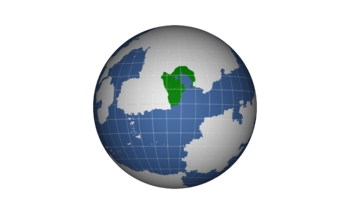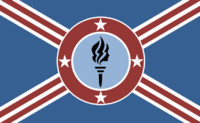Huvakia
The Imperial Hegemony of Huvakia The Empire of Huvakia | |
|---|---|
| Motto: Audi, Vide, Tace | |
| Anthem: Huvakia How Great are Thee | |
 | |
| Location | Southern Abos |
| Capital | Aegaeon |
| Largest city | Capital |
| Official languages | English |
| Recognised national languages | Russian |
| Demonym(s) | Huvakian |
| Government | Constitutional Imperial Monarchy |
• Emperor | Aleksander Zaetsev |
• Prime Minister | Sarif Igorav |
| Legislature | Imperial Parliment |
| Tribal Unification | |
• Unification Day: October 19, 1697 | Imperial Expansion March 14, 1743 |
| Population | |
• 2020 estimate | 87 Million |
| GDP (nominal) | estimate |
• Total | 4.750 Trillion |
• Per capita | 251,475 |
| HDI | .92 very high |
| Currency | Imperial Credit |
| Date format | dd-mm-yyyy |
| Driving side | right |
| Calling code | (767) |
The Imperial Hegemony of Huvakia more commonly known as Huvakia, is an efficient nation comprised of 16 contiguous states on the southern tip of Abos. Huvakia is notable for its compulsory military service, which is among the largest and most well equiped on the continent. An efficient economy, and near complete absence of crime among the population of 87 Million make Huvakia a regional power. The frighteningly efficient Huvakian economy, worth a remarkable 4.75 trillion Imperial Credits a year, is broadly diversified and led by the Arms Manufacturing industry, with significant contributions from Ship Building, Uranium Mining, and Soft Drink Manufacturing. State-owned companies are common. Crime, especially youth-related, is totally unknown, thanks to the all-pervasive police force and progressive social policies in education and welfare. Huvakia's national animal is the Rottweiler, which frolics freely in the nation's many lush forests.
In ancient times the lands that would become Huvakia were lagrely inhabiited by nomadic hunter gatherers. Eventually as discoveries like domestication and irrigation became widespread groups started to establish permanent settlements. Several of these settlements joined into an early confederation in the area that is now Aegaeon. Eventually through conflict and limited diplomacy the Kingdom of Aegaeon expanded to include much of the territory it possesses today.
History
Geography
Climate
Environment
Politics and Government
Military
The Emperor serves as supreme commander and chief of the armed forces which is administered by the Huvakian Ministry of Defense. The military is divided into 3 branches: the Army, Navy, and Air Force. All of these branches serve professionally, and have no other occupation. All citizens of Huvakia upon turning 18 are required by law to serve in a branch of the armed forces for no less than four years. This service can be deferred until the completion of collegiate education at which point admission takes place as an officer.
Foreign Relations
Economy
The Empire is the largest importer of goods on Abos and second-largest exporter, though exports per capita are relatively low. In 2010, the total Imperial trade deficit was $635 billion. Horikoru, Eldrado, and Bigtopia are among its top trading partners. In 2018, automobiles,hemp products, and information technology were the largest import commodity, while military equipment was the country's largest export.
Energy
The Imperial energy market is about 29,000 terawatt hours per year. Energy consumption per capita is 7.8 tons (7076 kg) of oil equivalent per year, the 10th-highest rate in the world. In 2005, 40% of this energy came from petroleum, 23% from coal, and 22% from natural gas. The remainder was supplied by nuclear power and renewable energy sources.The Empire is the world's second largest consumer of petroleum. The Empire has 27% of global coal reserves. Since 2007, the total greenhouse gas emissions by the Empire are the fourth highest by country. In more recent years the long term impacts of coal and oil have become more and more apparent. As such the Imperial government has conducted extensive research and development into more ecologically responsible forms of power generation. While traditional means of power acquisition are still in place they are being phased out whenever possible in favor of nuclear, solar, or wind.
Infrastructure
Issues that affect water supply in the Empire include droughts in the West, water scarcity, pollution, a backlog of investment, concerns about the affordability of water for the poorest, and a rapidly retiring workforce. Increased variability and intensity of rainfall as a result of climate change is expected to produce both more severe droughts and flooding, with potentially serious consequences for water supply and for pollution from combined sewer overflows.
Transport
Personal transportation is dominated by automobiles, which operate on a network of 2 million miles of public roads, including one of the world's longest highway systems at 57,000 mi (91,700 km). The world's second-largest automobile market, the Empire has the highest rate of per-capita vehicle ownership in the world, with 765 vehicles per 1,000 Imperials . The average adult (accounting for all drivers and non-drivers) spends 55 minutes driving every day, traveling 29 miles (47 km). In 2017, there were 255,009,283 motor vehicles—including cars, vans, buses, freight, and other trucks, but excluding motorcycles and other two-wheelers. Mass transit accounts for 19% of total work trips. Transport of goods and passengers by rail is extensive. Bicycle usage for work commutes is minimal. The civil airline industry is predominantly owned by the government though some foreign airlines are allowed to operate. All major airports are publicly owned. Of the world's 50 busiest passenger airports, 16 are in the Empire.


